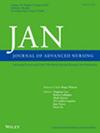住院病人静脉输液治疗中护士自述行为和开处方者期望:一项调查研究和临床文献回顾
IF 3.4
3区 医学
Q1 NURSING
引用次数: 0
摘要
目的评估自我报告的护士和开处方者(即医生和执业护士)在静脉输液治疗方面的实践和知识,并通过临床文献综述评估这些是如何记录的。设计多中心横断面研究,在2022年4月至2022年7月期间,横跨四家荷兰医院的13个病房。方法采用问卷调查的方法对自述的静脉输液相关行为进行评估。一份包含12个项目的调查问卷评估知识。为了深入了解文档实践,执行了回顾性图表审查。数据分析涉及描述性统计,适当时使用卡方检验或费雪精确检验分析组间差异。结果共304名医护人员完成问卷调查,其中护士占92%。大多数开处方者(n = 20/25; 80%)期望护士开始、停止或改变静脉输液治疗。总体而言,知识题正确答案的中位数为8 (IQR 7-9,范围0-12);4名参与者(1%)正确回答了所有知识问题。对0.9%氯化钠溶液的组成了解有限。对患者病历的分析显示,54%(196/362)接受静脉输液,最常见的是0.9%氯化钠输注(168/195;86%),尽管有3%(6/196)的患者描述了适应症。31%(61/196)的患者接受静脉输液以保持静脉畅通(< 30 mL/h)。结论:该研究确定了关于静脉输液的共同责任、知识差距和有限的文献。开处方者希望护士在不咨询开处方者的情况下调整静脉输液,这与护士的做法一致,尽管他们没有法律授权。鉴于静脉输液适应症的文献资料有限,一些患者接受了不必要的静脉输液似乎是合理的。结论:共同的责任为制定处方医生和护士共同参与的方案提供了机会,旨在指导更有针对性的输液治疗。影响减少不必要的输液以保持静脉畅通有助于消除低价值护理。报告方法cross准则。病人或公众捐款:没有病人或公众捐款。本文章由计算机程序翻译,如有差异,请以英文原文为准。
Nurses' Self-Reported Practices and Prescribers' Expectations in Intravenous Fluid Therapy for Hospitalised Patients: A Survey Study and Clinical Documentation Review.
AIMS
To assess self-reported practices and knowledge of nurses and prescribers (i.e., physicians and nurse practitioners) on intravenous fluid therapy, and to evaluate how this is documented through a clinical documentation review.
DESIGN
Multicentre cross-sectional study, between April 2022 and July 2022, across 13 wards from four Dutch hospitals.
METHODS
A survey study was conducted to assess self-reported practices related to intravenous fluid therapy. A 12-item questionnaire evaluated knowledge. To gain insights into documentation practices, a retrospective chart review was performed. Data analysis involved descriptive statistics, with group differences analysed using the chi-squared test or Fisher's exact test, as appropriate.
RESULTS
Three hundred and four healthcare professionals completed the questionnaire (92% nurses). The majority of prescribers (n = 20/25; 80%) expected that nurses would start, stop or change intravenous fluid therapy. Overall, the median number of correct answers to knowledge questions was eight (IQR 7-9, range 0-12); four participants (1%) answered all knowledge questions correctly. Knowledge about the composition of sodium chloride 0.9% solution was limited. Analysis of patient charts revealed that 54% (196/362) received intravenous fluids, most commonly 0.9% sodium chloride infusion (168/195; 86%), although the indication was described in 3% (6/196). Thirty-one percent (61/196) of patients received intravenous fluids to keep the vein open (< 30 mL/h).
CONCLUSION
The study identified shared responsibility, a knowledge gap, and limited documentation concerning intravenous fluids. Prescribers expect nurses to adjust intravenous fluids without consulting a prescriber, which aligns with what nurses do, although they are not legally authorised. Given the limited documentation of the indication for intravenous fluids, it is plausible that several patients received intravenous fluids unnecessarily.
IMPLICATIONS
The perceived shared responsibility presents an opportunity to develop a protocol engaging both prescribers and nurses, aiming to guide more targeted infusion therapy.
IMPACT
Reducing unnecessary infusions to keep-the-vein-open can help eliminate low-value care.
REPORTING METHOD
CROSS guideline.
PATIENT OR PUBLIC CONTRIBUTION
No patient or public contribution.
求助全文
通过发布文献求助,成功后即可免费获取论文全文。
去求助
来源期刊
CiteScore
6.40
自引率
7.90%
发文量
369
审稿时长
3 months
期刊介绍:
The Journal of Advanced Nursing (JAN) contributes to the advancement of evidence-based nursing, midwifery and healthcare by disseminating high quality research and scholarship of contemporary relevance and with potential to advance knowledge for practice, education, management or policy.
All JAN papers are required to have a sound scientific, evidential, theoretical or philosophical base and to be critical, questioning and scholarly in approach. As an international journal, JAN promotes diversity of research and scholarship in terms of culture, paradigm and healthcare context. For JAN’s worldwide readership, authors are expected to make clear the wider international relevance of their work and to demonstrate sensitivity to cultural considerations and differences.

 求助内容:
求助内容: 应助结果提醒方式:
应助结果提醒方式:


